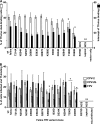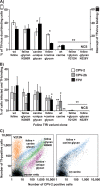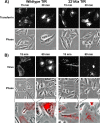Binding site on the transferrin receptor for the parvovirus capsid and effects of altered affinity on cell uptake and infection
- PMID: 20200243
- PMCID: PMC2863798
- DOI: 10.1128/JVI.02623-09
Binding site on the transferrin receptor for the parvovirus capsid and effects of altered affinity on cell uptake and infection
Abstract
Canine parvovirus (CPV) and its relative feline panleukopenia virus (FPV) bind the transferrin receptor type 1 (TfR) to infect their host cells but show differences in the interactions with the feline and canine TfRs that determine viral host range and tissue tropism. We changed apical and protease-like domain residues by introducing point mutations and adding or removing glycosylation signals, and we then examined the interactions of those mutant TfRs with the capsids. Most substitutions had little effect on virus binding and uptake. However, mutations of several sites in the apical domain of the receptor either prevented binding to the capsids or reduced the affinity of receptor binding to various degrees. Glycans within the virus binding face of the apical domain also controlled capsid binding. CPV, but not the related feline parvovirus, could use receptors containing a canine TfR-specific glycosylation to mediate efficient infection, while addition of other N-linked glycosylation sites into the virus binding face of the feline apical domain reduced or eliminated both binding and infection. Replacement of critical feline TfR residue 221 with every amino acid had effects on binding and infection which were significantly associated with the biochemical properties of the residue replaced. Receptors with reduced affinities mostly showed proportional changes in their ability to mediate infection. Testing feline TfR variants for their binding and uptake patterns in cells showed that low-affinity versions bound fewer capsids and also differed in attachment to the cell surface and filopodia, but transport to the perinuclear endosome was similar.
Figures






Similar articles
-
Residues in the apical domain of the feline and canine transferrin receptors control host-specific binding and cell infection of canine and feline parvoviruses.J Virol. 2003 Aug;77(16):8915-23. doi: 10.1128/jvi.77.16.8915-8923.2003. J Virol. 2003. PMID: 12885908 Free PMC article.
-
Purified feline and canine transferrin receptors reveal complex interactions with the capsids of canine and feline parvoviruses that correspond to their host ranges.J Virol. 2006 Sep;80(17):8482-92. doi: 10.1128/JVI.00683-06. J Virol. 2006. PMID: 16912298 Free PMC article.
-
Combinations of two capsid regions controlling canine host range determine canine transferrin receptor binding by canine and feline parvoviruses.J Virol. 2003 Sep;77(18):10099-105. doi: 10.1128/jvi.77.18.10099-10105.2003. J Virol. 2003. PMID: 12941920 Free PMC article.
-
[Evolution and host variation of the canine parvovirus: molecular basis for the development of a new virus].Berl Munch Tierarztl Wochenschr. 2004 Mar-Apr;117(3-4):130-5. Berl Munch Tierarztl Wochenschr. 2004. PMID: 15046459 Review. German.
-
Parvovirus host range, cell tropism and evolution.Curr Opin Microbiol. 2003 Aug;6(4):392-8. doi: 10.1016/s1369-5274(03)00083-3. Curr Opin Microbiol. 2003. PMID: 12941411 Review.
Cited by
-
Limited transferrin receptor clustering allows rapid diffusion of canine parvovirus into clathrin endocytic structures.J Virol. 2012 May;86(9):5330-40. doi: 10.1128/JVI.07194-11. Epub 2012 Feb 22. J Virol. 2012. PMID: 22357278 Free PMC article.
-
Host-specific parvovirus evolution in nature is recapitulated by in vitro adaptation to different carnivore species.PLoS Pathog. 2014 Nov 6;10(11):e1004475. doi: 10.1371/journal.ppat.1004475. eCollection 2014 Nov. PLoS Pathog. 2014. PMID: 25375184 Free PMC article.
-
Old and Novel Enteric Parvoviruses of Dogs.Pathogens. 2023 May 16;12(5):722. doi: 10.3390/pathogens12050722. Pathogens. 2023. PMID: 37242392 Free PMC article. Review.
-
Emerging virus diseases: can we ever expect the unexpected?Emerg Microbes Infect. 2012 Dec;1(12):e46. doi: 10.1038/emi.2012.47. Epub 2012 Dec 26. Emerg Microbes Infect. 2012. PMID: 26038413 Free PMC article. Review.
-
Structural Characterization of Cuta- and Tusavirus: Insight into Protoparvoviruses Capsid Morphology.Viruses. 2020 Jun 17;12(6):653. doi: 10.3390/v12060653. Viruses. 2020. PMID: 32560452 Free PMC article.
References
-
- Agbandje, M., R. McKenna, M. G. Rossmann, M. L. Strassheim, and C. R. Parrish. 1993. Structure determination of feline panleukopenia virus empty particles. Proteins 16:155-171. - PubMed
-
- Arnold, E., and M. G. Rossmann. 1990. Analysis of the structure of a common cold virus, human rhinovirus 14, refined at a resolution of 3.0 Å. J. Mol. Biol. 211:763-801. - PubMed
-
- Bates, G. W., and M. R. Schlabach. 1973. The reaction of ferric salts with transferrin. J. Biol. Chem. 248:3228-3232. - PubMed
Publication types
MeSH terms
Substances
Grants and funding
LinkOut - more resources
Full Text Sources
Other Literature Sources

